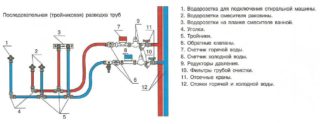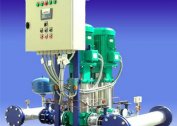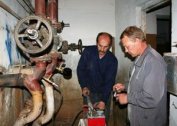Installation of a water supply system in an apartment is not a very complicated process at first glance. However, in order for this engineering system to work efficiently, you must correctly select the wiring diagram and the diameter of the pipes used. Properly conducted design improves the characteristics of the water supply system and reduces material costs for its assembly, maintenance and operation.
Wiring options for the plumbing system in the apartment
Two main circuits are used: collector and tee (serial). Each of the proposed systems has its pros and cons, so their plumbers are used for various situations related to the location and number of plumbing fixtures. Often, both schemes are used in the same apartment, creating a combined water supply system.
Sequential circuit
This is the easiest way to organize water supply inside the apartment. It consists of a pipe, which is connected to the central riser and carried out in all rooms where plumbing fixtures are located, which are connected to the main. In parallel to the cold water supply, pipes for hot water are laid.
 The main pipe in diameter should be larger than the sections of the lead to consumers. To connect plumbing fixtures to the main highway, they use a fitting - tee, therefore this connection scheme is often called a tee.
The main pipe in diameter should be larger than the sections of the lead to consumers. To connect plumbing fixtures to the main highway, they use a fitting - tee, therefore this connection scheme is often called a tee.
Designing such a piping and mounting is very simple. In all high-rise buildings built during the Soviet era, the water supply system was organized precisely according to this scheme. The main advantage is the low consumption of water pipes.
The serial system is only suitable for apartments in which there are few plumbing fixtures and the distance between them, as well as the riser, is small. The longer the water supply system of this type, the less pressure at the end of the pipe - the plumbing fixture located in this place may not work correctly. This is especially important for dishwashers and washing machines.
Collector circuit
 The scheme of collector wiring of water pipes in the apartment is twofold. Firstly, in such a system a large number of pipes and fittings are used, and a collector (comb) is also installed, so the network is expensive. Secondly, this is a uniform distribution of water among consumers - water flows to each of them with the same pressure.
The scheme of collector wiring of water pipes in the apartment is twofold. Firstly, in such a system a large number of pipes and fittings are used, and a collector (comb) is also installed, so the network is expensive. Secondly, this is a uniform distribution of water among consumers - water flows to each of them with the same pressure.
The installation diagram of the collector wiring is that one pipe is mounted from the riser to the collector. From the collector to each plumbing fixture, a separate pipe section is maintained. In addition, the collector (beam) water supply system of the apartment has another advantage - the ability to carry out repair work without disconnecting the entire network from the riser. Shut-off valves are installed on the comb in front of consumer branches, which, if necessary, are closed for repair work. At the same time, the rest of the circuits are operating normally.
Another advantage of the collector system is the ability to personalize the characteristics of each water circuit that is connected to a plumbing fixture. For example, for the high-quality operation of the washing machine, a filter is installed after the shut-off valve, which will trap impurities in the water. For the toilet, a filter is optional.
You can save a little if you correctly calculate the diameter of the required pipes. For a sink in the bathroom and sinks in the kitchen, a pipe with a diameter of 15 mm is installed. For the shower, the best option is 25 mm.For a toilet flush tank - 20.
Increasingly, experts recommend installing reducers before each consumer after the collector. With their help regulate the flow of water: pressure and volume.
In addition to the large consumption of materials, there are other disadvantages of this water supply system:
- only an experienced plumber can install a water supply system in a radiation-type apartment;
- It’s not always easy to find a place to mount the collector.
It is recommended that you first design the network taking into account the location of plumbing fixtures, determine the number of pipes, fittings, and other additional materials and then proceed directly to the installation work.
The collector for cold and hot water supply systems is installed separately. At the same time, shutoff valves in the form of ball valves or gate valves are mounted between them and the risers, with which you can cut off the entire water circuit from the riser. This is in case of extensive repairs or the dismantling of the system as a whole.
Integrated circuit
If the city apartment has a large area, it makes sense to combine the collector and tee system. The essence of the integrated approach is that not one, but several plumbing fixtures can be connected to one or two pipelines located after the comb. In this case, connect in series. For example, bring one pipe from the comb into the kitchen, and connect a sink and a dishwasher to it. In the bathroom, a sink and shower are connected to the pipe.
Such a connection will have the disadvantages of a serial system, but in some cases it is the best option. Minus wiring - disconnecting the entire branch during repair work. However, it is the combined approach that makes it possible to save a little on pipes and fittings.
The principle of the collector
The device is a pipe with one input and several outputs, which are located on the side of the structure. The inlet is always 30% larger than the lateral. This makes it possible to maintain the required pressure and volume of water inside the system, even if several consumers are switched on at the same time.
On the market, these devices are represented by different models that differ from each other in the material of manufacture:
- from stainless steel;
- brass;
- polymer.
The first two devices are attached to the pipes through a thread. This applies to the inlet and outlet. The latter variety, like all plastic and metal-plastic pipes, is fastened by welding or compression fittings.
There is another difference - the number of outlet pipes. The more of them, the larger the diameter of the main highway. The number of nozzles varies in the range from 3 to 6 pieces. If a large number of consumers (more than six) are present in the water supply network, two or three collectors are installed in series. In this case, combs with two through holes in the ends are used. Through them, the collectors are connected to each other.
Manufacturers offer collectors for cold water separately, for hot separately. The latter can be installed on the water supply network, through which cold water will move. The first type of comb cannot be mounted on hot water.
Devices are equipped with shut-off valves, which are installed on all nozzles. Such devices are more expensive, but there is no need to separately buy stop valves and attach to the comb. All connections are carried out in the factory with quality guarantees. The only minus of the connections at the factory is the inability to replace the cranes with new ones. If at least one crane fails, you will have to change the entire comb. Therefore, manufacturers produce collectors with a large guarantee of operation, which varies within 50 years.
Possible mistakes
The biggest mistake when laying a water supply system is incorrectly selected pipes in diameter for each plumbing fixture. Often the main branch in a serial circuit is assembled from a pipe of the same diameter as the branch sections to the plumbing. Even in small water pipes of this type of water, there is not always enough water, especially if all devices are operated simultaneously.
The second mistake concerns the location of pipes of hot and cold water passing in parallel. There are two positions:
- a hot pipe is always placed on top of a cold one;
- horizontal, the hot contour is to the right of the cold.
Hot water pipes must be insulated regardless of where they are laid. In this way, heat is stored and heat loss is reduced.




